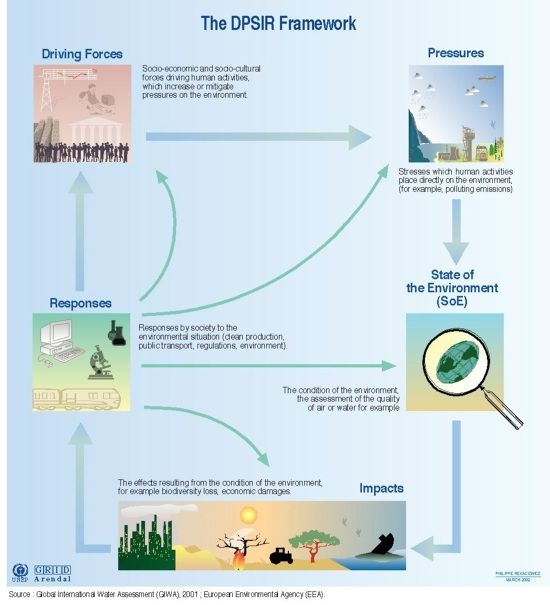Difference between revisions of "Building the Evidence: Diagnostic Report for ICZM"
| Line 30: | Line 30: | ||
• '''Responses''' are prioritisations with the aim to reduce negative impacts on environment, economy and society in general. Responses can affect any part of the chain between drivers and impacts. In case of ICZM Plan Process, the Responses should be discussed in form of proposals of how to deal with environmental issues. | • '''Responses''' are prioritisations with the aim to reduce negative impacts on environment, economy and society in general. Responses can affect any part of the chain between drivers and impacts. In case of ICZM Plan Process, the Responses should be discussed in form of proposals of how to deal with environmental issues. | ||
| + | |||
| + | |||
| + | '''[[Image:The-dpsir-framework e13e.jpg]] | ||
<small>See the schematic presentation of the DPSIR Framework proposed by Global International Water Assessment (GIWA), 2001; European Environment Agency (EEA)</small> | <small>See the schematic presentation of the DPSIR Framework proposed by Global International Water Assessment (GIWA), 2001; European Environment Agency (EEA)</small> | ||
Revision as of 14:24, 5 June 2012
Within the parameters of the objectives and indicators, the task is to better understand both the present context and the future flows of processes in the area. This is achieved by:
- Analyzing in greater detail the key problems and issues and, then, summarizing the existing conditions of the area and root causes, focusing on the agreed priorities (governance, environmental and socio-economic).
- Projecting the conditions forward on the basis of possible or likely trends for periods compatible with the lifespan of the ICZM strategy, plan or programme.
- Examining factors such as the goods and services provided by the ecosystem, along with wider area's issues such as erosion, land husbandry, deforestation and pollution (both point sources and diffuse).
The objectives, here, are two-fold: first, to ensure a solid basis for discussion, and second, to provide a basis for the visualisation, testing, development and discussion of alternative futures, in other words, "to make the invisible visible".
The value of local, or ethnic knowledge should also be recognised and sourced. It should be recognized that the affected citizens and employees in a coastal community may have a profound knowledge of the coastal system, and should be actively involved in the analysis in order to improve the quality of the analysis itself.
Techniques & Tools
Whilst technical data, measurable objectives and indicators are easily visible and underpin ICZM, it is the "intangibles" - the assumptions, interests, beliefs, agendas and real power structures - that must be engaged in order to allow any real progress. The challenge is how to create the preconditions for these intangibles to play their legitimate role in the process.
Much data and information will already be available, so the first task is to source, assess and re-present this. New research should only be required to fill the gaps or update the existing data and information.
Importantly, the data and information collected should be "fit for purpose" for its intended use i.e. these should be appropriate and of a necessary quality, without being excessively complex or more expensive to obtain than required.
One of the important ways of utilising the data at this stage is to perform the full Driver-Pressure-State-Impacts-Responses (DPSIR) framework. It is a tool that aims to develop appropriate management responses to certain environmental problems. It is a descriptive, simple and flexible cause-consequence loop which illustrates the links between human activities and environmental processes. It has been widely used in environmental research, as it helps stakeholders to understand the importance of natural systems in the decision-making, as well as the repercussions of economic activities.
The main elements of the DPSIR framework are:
• Drivers (or driving force of certain environmental problem) - they are a result of human needs to satisfy their primary (shelter, food, water, energy) and secondary requirements (mobility, culture, entertainment). They include social, economic and demographic changes in societies, which are reflected in changes in production and consumption levels, and people’s lifestyles in general.
• Drivers lead to pressures on the environment. They are results of production and consumption processes and, usually, they are reflected in increased emissions of harmful substances in the air, water and soil; changes in land use; excessive usage of certain goods; alterations of sediment and water cycle etc.
• Pressures result in altered state of the environment. The state of the environment represents the level of environmental quality, which is reflected in environment’s biological, physical and chemical conditions.
• Altered state of the environment exerts environmental and economic impacts on ecosystems (such as altered biodiversity, social and economic impacts, repercussions on human health etc.)
• Responses are prioritisations with the aim to reduce negative impacts on environment, economy and society in general. Responses can affect any part of the chain between drivers and impacts. In case of ICZM Plan Process, the Responses should be discussed in form of proposals of how to deal with environmental issues.
See the schematic presentation of the DPSIR Framework proposed by Global International Water Assessment (GIWA), 2001; European Environment Agency (EEA)
Future Trends
Future Trends will inevitably be speculative, based on retrospective data, or on accepted forecasts; most importantly they should be "likely" rather than "desirable" trends at this stage. This is, in essence, the conclusion of the diagnostic phase, which should describe what would happen if the present trends continued.
